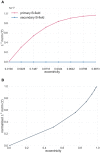The Discontinuous Galerkin Finite Element Method for Solving the MEG and the Combined MEG/EEG Forward Problem
- PMID: 29456487
- PMCID: PMC5801436
- DOI: 10.3389/fnins.2018.00030
The Discontinuous Galerkin Finite Element Method for Solving the MEG and the Combined MEG/EEG Forward Problem
Abstract
In Electro- (EEG) and Magnetoencephalography (MEG), one important requirement of source reconstruction is the forward model. The continuous Galerkin finite element method (CG-FEM) has become one of the dominant approaches for solving the forward problem over the last decades. Recently, a discontinuous Galerkin FEM (DG-FEM) EEG forward approach has been proposed as an alternative to CG-FEM (Engwer et al., 2017). It was shown that DG-FEM preserves the property of conservation of charge and that it can, in certain situations such as the so-called skull leakages, be superior to the standard CG-FEM approach. In this paper, we developed, implemented, and evaluated two DG-FEM approaches for the MEG forward problem, namely a conservative and a non-conservative one. The subtraction approach was used as source model. The validation and evaluation work was done in statistical investigations in multi-layer homogeneous sphere models, where an analytic solution exists, and in a six-compartment realistically shaped head volume conductor model. In agreement with the theory, the conservative DG-FEM approach was found to be superior to the non-conservative DG-FEM implementation. This approach also showed convergence with increasing resolution of the hexahedral meshes. While in the EEG case, in presence of skull leakages, DG-FEM outperformed CG-FEM, in MEG, DG-FEM achieved similar numerical errors as the CG-FEM approach, i.e., skull leakages do not play a role for the MEG modality. In particular, for the finest mesh resolution of 1 mm sources with a distance of 1.59 mm from the brain-CSF surface, DG-FEM yielded mean topographical errors (relative difference measure, RDM%) of 1.5% and mean magnitude errors (MAG%) of 0.1% for the magnetic field. However, if the goal is a combined source analysis of EEG and MEG data, then it is highly desirable to employ the same forward model for both EEG and MEG data. Based on these results, we conclude that the newly presented conservative DG-FEM can at least complement and in some scenarios even outperform the established CG-FEM approaches in EEG or combined MEG/EEG source analysis scenarios, which motivates a further evaluation of DG-FEM for applications in bioelectromagnetism.
Keywords: conservation properties; dipole; discontinous Galerkin; electroencephalography (EEG); finite element methods; magnetoencephalography (MEG); realistic head modeling; subtraction method.
Figures










Similar articles
-
A Mixed Finite Element Method to Solve the EEG Forward Problem.IEEE Trans Med Imaging. 2017 Apr;36(4):930-941. doi: 10.1109/TMI.2016.2624634. Epub 2016 Nov 2. IEEE Trans Med Imaging. 2017. PMID: 27831869
-
The Unfitted Discontinuous Galerkin Method for Solving the EEG Forward Problem.IEEE Trans Biomed Eng. 2016 Dec;63(12):2564-2575. doi: 10.1109/TBME.2016.2590740. Epub 2016 Jul 13. IEEE Trans Biomed Eng. 2016. PMID: 27416584
-
A realistic, accurate and fast source modeling approach for the EEG forward problem.Neuroimage. 2019 Jan 1;184:56-67. doi: 10.1016/j.neuroimage.2018.08.054. Epub 2018 Aug 28. Neuroimage. 2019. PMID: 30165251
-
CutFEM-based MEG forward modeling improves source separability and sensitivity to quasi-radial sources: A somatosensory group study.Hum Brain Mapp. 2024 Aug 1;45(11):e26810. doi: 10.1002/hbm.26810. Hum Brain Mapp. 2024. PMID: 39140847 Free PMC article. Review.
-
Review on solving the forward problem in EEG source analysis.J Neuroeng Rehabil. 2007 Nov 30;4:46. doi: 10.1186/1743-0003-4-46. J Neuroeng Rehabil. 2007. PMID: 18053144 Free PMC article. Review.
Cited by
-
Personalized tDCS for Focal Epilepsy-A Narrative Review: A Data-Driven Workflow Based on Imaging and EEG Data.Brain Sci. 2022 May 7;12(5):610. doi: 10.3390/brainsci12050610. Brain Sci. 2022. PMID: 35624997 Free PMC article. Review.
-
Brainstorm-DUNEuro: An integrated and user-friendly Finite Element Method for modeling electromagnetic brain activity.Neuroimage. 2023 Feb 15;267:119851. doi: 10.1016/j.neuroimage.2022.119851. Epub 2023 Jan 1. Neuroimage. 2023. PMID: 36599389 Free PMC article.
-
Comparative performance of the finite element method and the boundary element fast multipole method for problems mimicking transcranial magnetic stimulation (TMS).J Neural Eng. 2019 Apr;16(2):024001. doi: 10.1088/1741-2552/aafbb9. Epub 2019 Jan 3. J Neural Eng. 2019. PMID: 30605893 Free PMC article.
-
Conditions for numerically accurate TMS electric field simulation.Brain Stimul. 2020 Jan-Feb;13(1):157-166. doi: 10.1016/j.brs.2019.09.015. Epub 2019 Oct 3. Brain Stimul. 2020. PMID: 31604625 Free PMC article.
-
A comprehensive study on electroencephalography and magnetoencephalography sensitivity to cortical and subcortical sources.Hum Brain Mapp. 2021 Mar;42(4):978-992. doi: 10.1002/hbm.25272. Epub 2020 Nov 6. Hum Brain Mapp. 2021. PMID: 33156569 Free PMC article.
References
-
- Alkämper M., Dedner A., Klöfkorn R., Nolte M. (2016). The DUNE-ALUGrid module. Arch. Numer. Softw. 4, 1–28.
-
- Aydin Ü., Rampp S., Wollbrink A., Kugel H., Cho J.-H., Knösche T. R., et al. . (2017). Zoomed MRI guided by combined EEG/MEG source analysis: a multimodal approach for optimizing presurgical epilepsy work-up and its application in a multi-focal epilepsy patient case study. Brain Topogr. 30, 417–433. 10.1007/s10548-017-0568-9 - DOI - PMC - PubMed
LinkOut - more resources
Full Text Sources
Other Literature Sources
Research Materials

